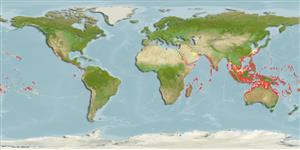>
Lophiiformes (Anglerfishes) >
Antennariidae (Frogfishes)
Etymology: Antennarius: From Latin, antenna, antemna = sensory organ (Ref. 45335).
Eponymy: Dr Philibert Commerson (1727–1773) was known as ‘doctor, botanist and naturalist of the King’. [...] (Ref. 128868), visit book page.
More on author: Lacepède.
Environment: milieu / climate zone / تغييرات عمق / distribution range
بوم شناسي
دريايي وابسته به آب سنگ; تغييرات عمق 0 - 70 m (Ref. 89972), usually ? - 20 m (Ref. 9269). Tropical; 32°N - 32°S
Indo-Pacific and Eastern Pacific: Red Sea and South Africa (Ref. 4113) to Panama, north to southern Japan and the Hawaiian Islands, south to the Lord Howe and the Society islands. Referred to as Antennarius moluccensis by authors.
Size / Weight / سن
بلوغ: Lm ? range ? - ? cm
Max length : 45.0 cm TL جنس نر / بدون خواص جنسي; (Ref. 90102)
خارهاي باله پشتي (کل) : 3; شعاع نرم باله پشتي (کل) : 12 - 13; خارهاي باله مخرجي: 0; شعاع نرم باله مخرجي: 8. Comes in a variety of colors: yellow, orange, green, brown, and black. Bony part of illicium about equal to length of the 2nd dorsal spine (10.2-16.9 %SL); esca a small tuft of flattened appendages (Ref. 4538). Illicial length in %SL: 19.3-25.2 (Ref. 6773). Membrane behind 2nd dorsal spine thick and spinulose, extending to base of third (Ref. 6773). One of the largest species (Ref. 48635).
Body shape (shape guide): short and / or deep; Cross section: compressed.
Found in lagoon and seaward reefs (Ref. 9710), often on jetty (Ref. 48635). Benthic (Ref. 58302). Feed on fish (Ref. 11889) and small shrimps (Ref. 89972). Oviparous. Eggs are bound in ribbon-like sheath or mass of gelatinous mucus called 'egg raft' or 'veil' (Ref. 6773). Solitary and frequently among sponges in 1-50 m, usually less than 20 m (Ref 90102).
Life cycle and mating behavior
بلوغ | تولید مثل | تخم ریزی | تخم ها | Fecundity | توزاد ( لارو)
Oviparous. Eggs are bound in ribbon-like sheath or mass of gelatinous mucus called 'egg raft' or 'veil' (Ref. 6773).
Pietsch, T.W. and D.B. Grobecker, 1987. Frogfishes of the world. Systematics, zoogeography, and behavioral ecology. Stanford University Press, Stanford, California. 420 p. (Ref. 6773)
وضعيت در فهرست قرمز IUCN (Ref. 130435: Version 2025-1)
خطر برای انسان ها
Harmless
استفاده انسانی
ماهي گيري – شيلات: از بی علاقه گی
ابزارها
گزارش های ويژه
بارگيری XML
منابع اينترنتي
Estimates based on models
Preferred temperature (مرجع
123201): 24.5 - 29, mean 27.9 °C (based on 652 cells).
Phylogenetic diversity index (مرجع
82804): PD
50 = 0.5002 [Uniqueness, from 0.5 = low to 2.0 = high].
Bayesian length-weight: a=0.02630 (0.01029 - 0.06725), b=2.96 (2.73 - 3.19), in cm total length, based on LWR estimates for this (Sub)family-body shape (Ref.
93245).
Trophic level (مرجع
69278): 4.2 ±0.73 se; based on food items.
جهندگی (مرجع
120179): زياد, كمينه زمان لازم براي دو برابر شدن جمعيت ، كمتر از 15 ماه (Fec assumed to be > 10,000).
Fishing Vulnerability (Ref.
59153): Low to moderate vulnerability (35 of 100).
🛈
Nutrients (Ref.
124155): Calcium = 35.3 [17.9, 59.7] mg/100g; Iron = 0.568 [0.304, 0.993] mg/100g; Protein = 19 [17, 22] %; Omega3 = 0.105 [0.040, 0.254] g/100g; Selenium = 34.5 [16.4, 78.0] μg/100g; VitaminA = 101 [26, 373] μg/100g; Zinc = 0.82 [0.53, 1.24] mg/100g (wet weight);
